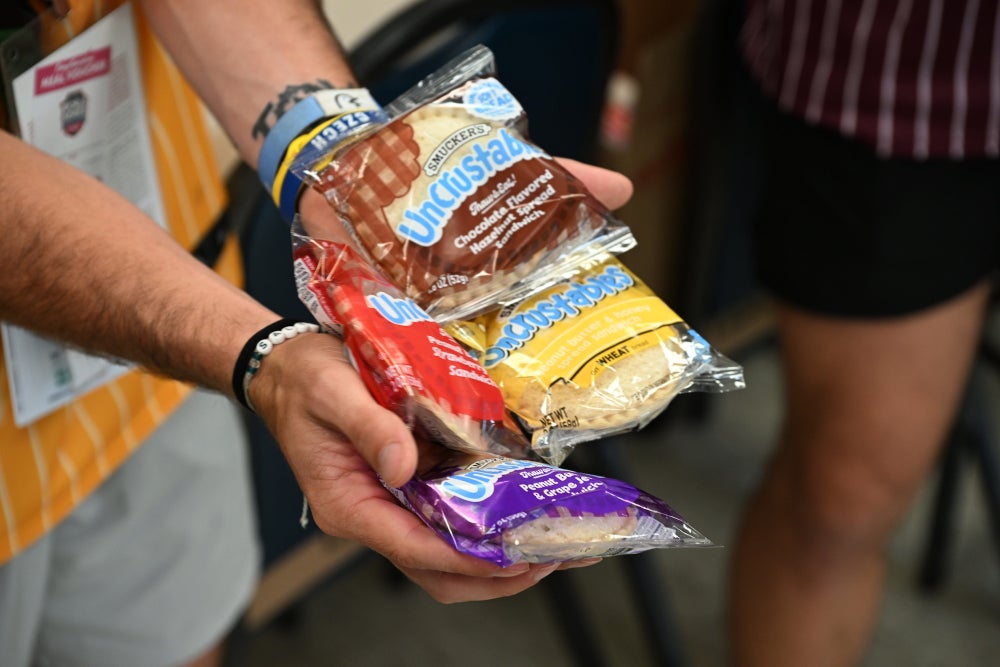Key Takeaways
- The J.M. Smucker Co. is suing Trader Joe’s over an alleged Uncrustables knockoff.
- Smucker’s says it has spent a billion dollars developing and marketing the thaw-to-eat peanut butter and jelly sandwich over the last two decades.
- The food maker alleges that Trader Joe’s violated its various trademarks, including the image of “a round crustless sandwich with a bite taken out showing filling on the inside.”
Trader Joe’s is well-known for its fun food creations and dupes of popular snacks, but one new product has landed the grocer in a legal battle.
The J.M. Smucker Co. filed a lawsuit against Trader Joe’s in federal court in Ohio on Monday, alleging that Trader Joe’s has violated its design and packaging trademarks with its round, crustless peanut butter and jelly sandwiches.
The J.M. Smucker Co. is the parent company to Smucker’s, which makes Uncrustables, a lunchbox staple in the U.S. for more than two decades (the sandwich debuted in its current form in 2000). In the filing, the company said it has spent more than $1 billion on marketing and product development for the product over 25 years, per The New York Times.
Uncrustables’ thaw-to-eat and handheld design has made it a popular lunchbox staple for parents and kids — and a halftime snack for athletes.
Last year, The Athletic reported that the National Football League’s various teams go through more than 80,000 of the small sandwiches a year. It makes sense for sports: They’re individually wrapped, which keeps them sanitary; small, which makes them fast and easy to eat; and packed with protein (in late September, Smucker’s released two new flavors with 12 grams of protein in each sandwich).
The New York Times notes that while you can’t trademark a sandwich, you can trademark shapes, configurations, and packaging designs. In this case, Smucker’s says in the lawsuit that it trademarked “a round pie-like shape with distinct peripheral undulated crimping” and also the image of “a round crustless sandwich with a bite taken out showing filling on the inside.”
Related: Smucker’s Employees Actually Want to Go Into the Office — Here’s Why

“Smucker does not take issue with others in the marketplace selling prepackaged, frozen, thaw-and-eat crustless sandwiches. But it cannot allow others to use Smucker’s valuable intellectual property to make such sales,” the company said in its lawsuit.
Trader Joe’s has not yet commented, though some outside analysts suggest their lawyers will argue that their product is more square.
Related: Hostess Brands Finds a New Owner in Jam Giant J.M. Smucker in $5.6 Billion Deal
Key Takeaways
- The J.M. Smucker Co. is suing Trader Joe’s over an alleged Uncrustables knockoff.
- Smucker’s says it has spent a billion dollars developing and marketing the thaw-to-eat peanut butter and jelly sandwich over the last two decades.
- The food maker alleges that Trader Joe’s violated its various trademarks, including the image of “a round crustless sandwich with a bite taken out showing filling on the inside.”
Trader Joe’s is well-known for its fun food creations and dupes of popular snacks, but one new product has landed the grocer in a legal battle.
The J.M. Smucker Co. filed a lawsuit against Trader Joe’s in federal court in Ohio on Monday, alleging that Trader Joe’s has violated its design and packaging trademarks with its round, crustless peanut butter and jelly sandwiches.
The J.M. Smucker Co. is the parent company to Smucker’s, which makes Uncrustables, a lunchbox staple in the U.S. for more than two decades (the sandwich debuted in its current form in 2000). In the filing, the company said it has spent more than $1 billion on marketing and product development for the product over 25 years, per The New York Times.
The rest of this article is locked.
Join Entrepreneur+ today for access.


